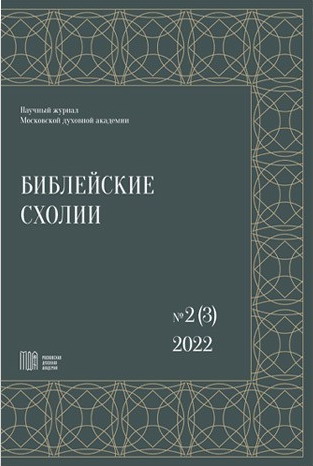Christ as the One Who Completes the Act of Creation in the Gospel of John: From «ἤρξατο ὁ Θεὸς ποιῆσαι» (Gen. 2, 3) to «τετέλεσται» (Jn. 19, 30)
DOI:
https://doi.org/10.31802/BSCH.2022.3.2.001Keywords:
Gospel of John, the Book of Genesis, the Prologue, the theme of creation, anthropology, soteriology, lexicological, comparative analysis, the Hexameron, system of imagesAbstract
The purpose of this work is to prove that one of the central themes of the Prologue — the theme of creation — is not only mentioned in the Gospel, but is one of the central ones in the narrative. The author begins with the thesis, which is widespread among modern researchers, that the main idea of the Prologue of the Gospel of John — the theme of creation — is not reflected in the rest of the narrative. The author consistently proves that in fact the theme of creation is a central axis in the theological consciousness of the Evangelist, where «The work of Christ» (John 17, 5) is the completion of the «Hexameron», i. e. of the act of the creation of the world by God (see John 19, 30). The article mentions some ideas of modern authors, where the theme of the six days of creation in the book of Genesis is reflected in the Gospel text. The image-symbol «The Gardener» (see John 20, 15) is the key that leads to discovery of John’s intention: The Evangelist operates with a system of images that consistently point to the theme of creation from the Book of Genesis. The following section of the article cites some ideas of the Holy Fathers (Irenaeus of Lyons, Athanasius of Alexandria, John Chrysostom), who think that the evangelist’s intention is to present Christ as the Creator of the cosmos. This article argues that the text of the Septuagint represents the process of creation as incomplete, as only the initial stage (see Genesis 2, 3: «... ὧν ἤρξατο ὁ θεὸς ποιῆσαι»). In John’s theology the continuation of the Act of creation (the Hexameron) is passed on to Christ, who accomplishes this «work» of creation (see John 17, 5). In support of this discovery, the author presents some lexicological borrowings from the initial chapters of Genesis, namely the terms «works» (τὰ ἔργα), «accomplish» (τελέω) or «create» (ποιόω): these are taken on by the Evangelist are reapplied to the mission Christ. It sheds some light on the final word of Christ «τετέλεσται» in John 19, 30. It is seen as the proclamation that the act of Genesis (1–2 chapters) is finally completed. In conclusion, the article proves that the crown of creation and the object of Christ’s mission is not so much the material world but man-humanity, in its multi-hypostatic unity: the process of creation ends at Golgotha.
Downloads
References
Афанасий Великий, свт. Слово о Воплощении Бога-Слова, и о пришествии Его к нам во плоти // Творения, иже во святых отца нашего Афанасия Великого, архиепископа Александрийского. Ч. 1. Сергиев Посад: СТСЛ, 2 1902. С. 191–263.
Иоанн Златоуст, свт. Беседы на Евангелие святого апостола Иоанна Богослова // Творения святого отца нашего Иоанна Златоуста, архиепископа Константинопольского, в русском переводе. Т. 8. Кн. 1–2. СПб.: Изд. СПБДА, 1902. С. 5–604.
Ириней Лионский, сщмч. Против Ересей. Доказательство апостольской проповеди. СПб.: Изд. Олега Абышко, 2008.
Триодь Постная: в 2-х ч. М.: Изд. Московской Патриархии, 1992.
Триодь Цветная. М.: Изд. Московской Патриархии, 1992.
Appold M. L. The Oneness Motif in the Fourth Gospel: Motif Analysis and Exegetical Probe into the Theology of John. Tübingen: J. C. B. Mohr [Paul Siebeck], 1976. (WUNT; Bd. 2/1).
Behr J. John the Theologian and his Paschal Gospel. A Prologue to Theology. Oxford: Oxford University Press, 2019.
Beutler J. Der Johannes-Prolog — Ouvertüre des Johannesevangeliums // Der Johannesprolog / hrsg. G. Kruck. Darmstadt: Wissenschaftliche Buchgesellschaft, 2009. P. 77–106.
Black D. A. On the Style and Significance of John 17 // Criswell Theological Review. 1988. Vol. 3. P. 141–159.
Blanquart F. Le premier jour. Etude sur Jean 20. Paris: Cerf, 1992.
Bradford B. B. Peter in The Gospel of John: The Making of an Authentic Di sciple. Leiden: Brill, 2007.
Brodie T. L. The Gospel According to John: A Literary and Theological Commentary. New York (N. Y.): Oxford University Press, 1993. Brodie T. L. The Quest for the Origin of John’s Gospel: A Source-Oriented Approach. New York (N. Y.): Oxford University Press, 1993. Brown J. K. Creation’s Renewal in the Gospel of John // Catholic Biblical Quarterly. 2010. Vol. 72. P. 275–290.
Brown R. E. The Gospel According to John. Vol. 1. Garden City (N. Y.): Doubleday, 1966.
Bultmann R. The Gospel of John: A Commentary. Louisville (Ky.): Westminster John Knox, 1971.
Byers A. J. Ecclesiology and Theosis in the Gospel of John. Cambridge: Cambridge University Press, 2017. (Society for New Testament Studies Monograph Series).
Carmichael С. M. The Story of Creation: Its Origin and Its Interpretation in Philo and the Fourth Gospel. Ithaca (N. Y.): Cornell University Press, 1996.
Coloe M. L. Theological Reflexions on Creation in the Gospel of John // Pacifica. 2011. Vol. 24. P. 1–12.
Culpepper Α. Anatomy of the Fourth Gospel: A Study in Literary Design. Philadelphia (Pa.): Fortress, 1983.
Hambly W. F. Creation and Gospel: A Brief Comparison of Genesis 1, 1–2, 4 and John 1, 1–2, 12 // Studia Evangelica / ed. F. L. Cross. Vol. 5. Berlin: Akademie Verlag, 1968. P. 69–74.
Hamid-Khani S. Revelation and Concealment of Christ: A Theological Inquiry into the Elusive Language of the Fourth Gospel. Tubingen: Mohr Siebeck, 2000. (WUNT 2 Reihe; Bd. 120).
Heath J. Some Were Saying, He is Good (John 7.12b): «Good» Christology in John’s Gospel? // Journal of New Testament Studies. 2010. Vol. 56. P. 513–535.
Henry W. M. The Trinity in John: A Study in Relationships. (Paperback). Fortland (Mo.): The Open Bible Trust, 2017.
Holleran J. W. Seeing the Light: A Narrative Reading of John 9 // Ephemerides Theologicae Lovanienses. 1993. Vol. 69. P. 354–82.
Hooker M. D. Endings: Invitations to Discipleship. Peabody (Mass.): Hendrickson, 2003.
Keener C. S. The Gospel of John: A Commentary. Vol. 1–2. Grand Rapids (Mich.): Baker Publishing Group, 2010.
Kruse C. G. The Letters of John. Pillar New Testament Commentary. Grand Rapids (Mich.): Wm. B. Eerdmans Publishing, 2000.
Lange J. P. The Life of the Lord Jesus Christ: A Complete Critical Examination of the Origin, Contents, and Connection of the Gospels. Vol. 3. Edinburg: T. & T. Clark, 1872.
Lindars B. The Gospel of John. London: Oliphants, 1972.
Manns F. L’Evangile de Jean à la lumière du Judaïsme. Jerusalem: Franciscan Printing, 1991.
Moore A. M. Signs of Salvation: The Theme of Creation in John’s Gospel. Cambridge: James Clarke, 2013.
Panackel С. Ἰδοὺ ὁ Ἄνθρωπος (Jn. 19:5b): An Exegetico-Theological Study of the Text in the Light of the Use of the Term Ἄνθρωπος Designating Jesus in The Fourth Gospel. Rome: Gregorian & Biblical, 1988.
Rand J. A., du. The Creation Motif in The Fourth Gospel: Perspectives on Its Narratological Function within a Judaistic Background // Theology and Christology in the Fourth Gospel / ed. G. van Belle, J. G. van der Watt, P. J. Maritz. Leuven: Peeters, 2005. P. 21–46. Rheaume R. An Exegetical and Theological Analysis of the Son’s Relationship to the Father in John’s Gospel: Equal Yet Subordinate. New York (N. Y.): The Edwin Mellen Press, 2015.
Siliezar C. R. S. Creation Imagery in the Gospel of John. London: Bloomsbury T&T Clark, 2015. (The Library of New Testament Studies; vol. 546).
Simon L. Petrus und der Lieblingsjünger im Johannesevangelium: Amt und Autorität. Frankfurt: Peter Lang, 1994.
Stanley D. M. The Passion According to John // Worship. 1959. Vol. 33. P. 210–230.
Strimple R. B. The Modern Search for the Real Jesus: An Introductory Survey of the Historical Roots of Gospels Criticism. Philipsburg (N. J.): P&R Publishing Company, 1995.
Suggit J. N. Jesus the Gardener: The Atonement in the Fourth Gospel as Re-Creation // Neotes ta men ti ca. 1999. Vol. 33. P. 161–168. Thompson M. The God of the Gospel of John. Grand Rapids (Mich.): Eerdmans, 2001.
Tong F.-D. Gathering into One: A Study of the Oneness Motif in the Fourth Gospel with Special Reference to Johannine Soteriology. St. Louis (Mo.): Christ Seminary-Seminex, 1992.
Voortman T. C. Understanding the Fourth Gospel from the Perspective of the Creation Theme / D. Litt. et Phil. diss. Dept. of Biblical and Religious Studies, Rand Afrikaans University. Johannesburg, 1998.
Waetjen H. C. The Gospel of the Beloved Disciple: A Work in Two Editions. London: T&T Clark International, 2005.
Watt J. G., van der. «Working the Works of God»: Identity and Behaviour in the Gospel of John // Paul, John, and Apocalyptic Eschatology: Studies in Honour of Martinus C. de Boer / ed. J. Krans, B. J. L. Peerbolte, P.-B. Smit, A. Zwiep. Leiden: Brill, 2013. (Supplements to Novum Testamentum; vol. 149). P. 135–150.
Wyatt N. «Supposing Him to Be the Gardener» (John 20, 15): A Study of the Paradise Motif in John // Zeitschrift für die Neutestamentlic he Wissenschaft. 1990. Vol. 25. P. 21–38.
Zumstein J. Der Prolog, Schwelle zum vierten Evangelium // Der Johannesprolog / hrsg. G. Kruck. Darmstadt: Wissenschaftliche Buchgesellschaft, 2009. S. 49–75.
Downloads
Published
How to Cite
Issue
Section
Categories
License

This work is licensed under a Creative Commons Attribution-ShareAlike 4.0 International License.






